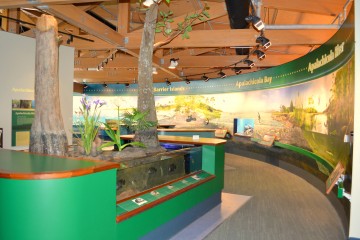Encouraging Conservation, Preservation & Restoration

E.O. Wilson Biophilia Center at Nokuse Plantation
The center honors the legacy of famed entomologist E. O. Wilson. Founded by local businessman and conservationist M.C. Davis, Nokuse Plantation comprises 50,000+ acres of Longleaf Pine ecosystem. Ranked as the 6th most biodiverse area in the continental United States, less than 2% of it remains intact today. As such, it’s an ideal place from which to educate students on the importance of biodiversity and to encourage conservation, preservation, and restoration. Designed by architect Anthony Vallee, this state-of-the-art learning center enables visitors to witness a working beehive, see rare bird species, observe several species of snakes and frogs, view wildlife dioramas, and learn from the organization’s wildlife experts. Though the Center’s focus is on 4th and 7th-grade classroom education, it is open to the public on the first Saturday of the month.

Apalachicola National Estuarine Research Reserve & Visitor/Nature Center
Not to be missed, the Center richly interprets the diverse habitat found within this 246,000-acre reserve, which is one of 25 sites designated by the National Oceanic and Atmospheric Administration to provide long-term estuarine research and monitoring, education and interpretation, and resource management, as a basis for more informed coastal management decisions. The 3,000-square-foot center features marine habitat displays, including three simulations of key aquatic habitats in the river, bay, and gulf. The Howell Building houses a 100-seat capacity auditorium, is equipped for slide and video presentations, and provides space for the Reserve’s monthly guest lecture series.
